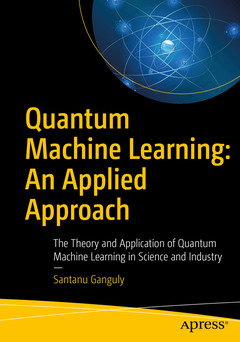Quantum Machine Learning: An Applied Approach, 1st ed. The Theory and Application of Quantum Machine Learning in Science and Industry
Auteur : Ganguly Santanu

Know how to adapt quantum computing and machine learning algorithms. This book takes you on a journey into hands-on quantum machine learning (QML) through various options available in industry and research.
The first three chapters offer insights into the combination of the science of quantum mechanics and the techniques of machine learning, where concepts of classical information technology meet the power of physics. Subsequent chapters follow a systematic deep dive into various quantum machine learning algorithms, quantum optimization, applications of advanced QML algorithms (quantum k-means, quantum k-medians, quantum neural networks, etc.), qubit state preparation for specific QML algorithms, inference, polynomial Hamiltonian simulation, and more, finishing with advanced and up-to-date research areas such as quantum walks, QML via Tensor Networks, and QBoost.
Hands-on exercises from open source libraries regularly used today in industry and research are included, such as Qiskit, Rigetti's Forest, D-Wave's dOcean, Google's Cirq and brand new TensorFlow Quantum, and Xanadu's PennyLane, accompanied by guided implementation instructions. Wherever applicable, the book also shares various options of accessing quantum computing and machine learning ecosystems as may be relevant to specific algorithms.
The book offers a hands-on approach to the field of QML using updated libraries and algorithms in this emerging field. You will benefit from the concrete examples and understanding of tools and concepts for building intelligent systems boosted by the quantum computing ecosystem. This work leverages the author?s active research in the field and is accompanied by a constantly updated website for the book which provides all of the code examples.
What You will Learn
- Understand and explore quantum computing and quantum machine learning, and their application in science and industry
- Explore various data training models utilizing quantum machine learning algorithms and Python libraries
- Get hands-on and familiar with applied quantum computing, including freely available cloud-based access
- Be familiar with techniques for training and scaling quantum neural networks
- Gain insight into the application of practical code examples without needing to acquire excessive machine learning theory or take a quantum mechanics deep dive
Chapter Goal: Introduction to book and topics to be covered
No of pages 12
Sub -Topics
1. Rise of The Quantum Computers
2. Learning from data: AI, ML and Deep Learning
3. Way forward
4. Bird’s Eye view of Quantum Machine Learning Algorithms
5. Organisation of the book6. Software and Languages (Linux and Python libraries)
1. Chapter Goal: A comprehensive understanding of key concepts related to Quantum information science and cloud based free access options for quantum computation quantum domain with examples
No of pages: 65
Sub - Topics:
2. Basics of Quantum Computing: Qubits, Bloch sphere and gates
3. Quantum Circuits
4. Quantum Parallelism
5. Quantum Computing by Annealing6. Quantum Computing with Superconducting qubits
7. Other flavours of Quantum Computing
8. Algorithms: Grover, Deutsch, Deutsch-Josza
9. Optimisation theory
10. Hands-on exercises
Chapter 3: Quantum Information Encoding
Chapter Goal:To understand how to encode data in quantum machine learning space with examples
No of pages: 30
Sub - Topics:
26. Initiation and selection of data27. Basis encoding
28. Superposition of inputs
29. Sampling Theory
30. Hamiltonian
31. Amplitude Encoding
32. Other Encoding techniques
33. Hands-on exercises
Chapter 4: QML Algorithms
Chapter Goal: Understanding hardware driven algorithmic computations for quantum machine learning
No of pages: 35
Sub - Topics:
34. Hardware Interface (Quantum Processors)
35. Quantum K-Means and K-Medians36. Quantum Clustering
37. Quantum Classifiers (e.g., nearest neighbours)
38. Support Vector Machine (SVM) in quantum space
39. Hands-on exercises
Chapter 5: Inference
Chapter Goal: Models and methods used in Quantum Machine Learning
No of pages: 35
Sub - Topics:
40. Principal Component Analysis
41. Feature Maps
42. Linear Models
43. Probabilistic Models
44. Hands-on ExercisesChapter 6: Training the Data
Chapter Goal: Training models and techniques of Quantum Machine Learning
No of pages: 105
Sub - Topics:
45. Unsupervised and supervised learning
46. Matrix inversion
47. Amplitude amplification for QML
48. Quantum optimization
49. Travelling Salesman Problem
50. Variational Algorithms
51. QAOA
52. Maxcut Problem
53. VQE (Virtual Quantum Eigensolver)54. Varitaional Classification algorithms
55. Hands-on Exercises
Chapter 7: Quantum Learning Models
Chapter Goal: Learning models and techniques of Quantum Machine Learning
No of pages: 75
Sub - Topics:
56. Optimal state for learning
57. Channel State duality58. Tomography
59. Quantum Neural Networks
60. Quantum Walk
61. Tensor Network applications
62. Hands-on Exercises
Chapter 8: Future of QML in Research and Industry
Chapter Goal: Forward looking prospects of Quantum Machine Learning in industry, enterprises and opportunities
No of pages: 15
Sub - Topics:
1. Speed up that Big Data
2. Effect of Error Correction
3. Machine learning marries Quantum Computing
4. QBoost
5. Quantum Walk
6. Mapping to hardware7. Hands-on Exercises
References IndexSantanu Ganguly has been working in the fields of quantum technologies, cloud computing, data networking, and security (on research, design, and delivery) for over 21 years. He works in Switzerland and the United Kingdom (UK) for various Silicon Valley vendors and ISPs. He has two postgraduate degrees (one in mathematics and another in observational astrophysics), and research experience and publications in nanoscale photonics and laser spectroscopy. He is currently leading global projects out of the UK related to quantum communication and machine learning, among other technologies.
The first book related to hands-on aspects of quantum machine learning
Optimized for self-study without jargon and centered on easy reading
Code examples utilizing open source libraries and languages are available for download from the book's website
Covers all of the most important quantum machine learning algorithms, with practical examples
Date de parution : 07-2021
Ouvrage de 551 p.
17.8x25.4 cm



